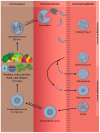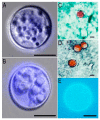Cyclospora cayetanensis and Cyclosporiasis: An Update
- PMID: 31487898
- PMCID: PMC6780905
- DOI: 10.3390/microorganisms7090317
Cyclospora cayetanensis and Cyclosporiasis: An Update
Abstract
Cyclospora cayetanensis is a coccidian parasite of humans, with a direct fecal-oral transmission cycle. It is globally distributed and an important cause of foodborne outbreaks of enteric disease in many developed countries, mostly associated with the consumption of contaminated fresh produce. Because oocysts are excreted unsporulated and need to sporulate in the environment, direct person-to-person transmission is unlikely. Infection by C. cayetanensis is remarkably seasonal worldwide, although it varies by geographical regions. Most susceptible populations are children, foreigners, and immunocompromised patients in endemic countries, while in industrialized countries, C. cayetanensis affects people of any age. The risk of infection in developed countries is associated with travel to endemic areas and the domestic consumption of contaminated food, mainly fresh produce imported from endemic regions. Water and soil contaminated with fecal matter may act as a vehicle of transmission for C. cayetanensis infection. The disease is self-limiting in most immunocompetent patients, but it may present as a severe, protracted or chronic diarrhea in some cases, and may colonize extra-intestinal organs in immunocompromised patients. Trimetoprim-sulfamethoxazole is the antibiotic of choice for the treatment of cyclosporiasis, but relapses may occur. Further research is needed to understand many unknown epidemiological aspects of this parasitic disease. Here, we summarize the biology, epidemiology, outbreaks, clinical symptoms, diagnosis, treatment, control and prevention of C. cayetanensis; additionally, we outline future research needs for this parasite.
Keywords: Cyclospora; control; diagnosis; epidemiology; humans; life cycle.
Conflict of interest statement
The authors declare that there is no conflict of interest regarding the publication of this paper.
Figures


References
-
- Smith H.V., Paton C.A., Girdwood R.W.A., Mtambo M.M.A. Cyclospora in non-human primates in Gombe, Tanzania. Vet. Rec. 1996;138:528. - PubMed
Publication types
LinkOut - more resources
Full Text Sources

